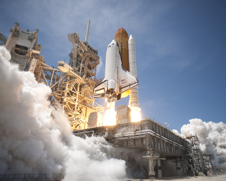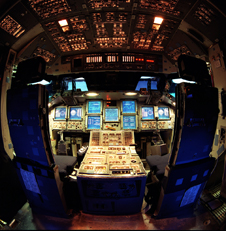October 29, 2010 Vol. 3, Issue 10
This month marks the 25th anniversary of the first flight of the Space Shuttle Atlantis.

An exhaust plume surrounds the mobile launcher platform as Atlantis launches. Photo Credit: NASA/Tony Gray and Tom Farrar
Over 40,000 watched the space shuttle Atlantis launch on Friday, May 14, 2010, just months shy of its 25th birthday this October. “There are thousands of folks out there who have taken care of this bird for a long time,” said Commander Kenneth Ham during the final voyage of Atlantis. “We’re going to take her on her 32nd flight, and if you don’t mind, we’ll take her out of the barn and make a few more laps around the planet.”
Atlantis, or Orbiter Vehicle-104, was delivered to Kennedy Space Center on April 9, 1985. Thanks to the lessons learned from constructing Enterprise,Columbia, and Challenger, Atlantis was completed in half the man-hours it took to build Columbia. When fitted with its main engines, Atlantis weighs 171,000 pounds, nearly 7,000 pounds lighter than Columbia. This weight differential was largely due to the installation of large thermal protection blankets on the upper body of the orbiter instead of individual tiles.

The Multifunction Electronic Display Subsystem (MEDS) or “glass cockpit” installed in the shuttle mission simulator at Johnson Space Center. Photo Credit: NASA
Atlantis‘s first mission, STS-51-J, carried a classified payload for the Department of Defense (DOD) into space on October 3, 1985. In the years that followed, Atlantis carried four more DOD payloads in addition to the Magellan, Galileo, and Compton Gamma Ray Observatory spacecraft into space. The shuttle also delivered the Destiny module, the Joint Airlock Quest, and multiple sections of the Integrated Truss to the International Space Station. Atlantis also pioneered the first Shuttle-Mir missions, starting with STS-71.
In 2000, Atlantis flew STS-101 as the first orbiter to be outfitted with a new display addition called the Multifunctional Electronic Display System, also known as the “glass cockpit.” The 11 full-color, flat-panel display screens replaced 32 gauges and electromechanical displays and four cathode-ray tube displays. The new display was 75 pounds lighter than the previous one. Improvements to the cockpit were made again in 2005.
Atlantis was named after a two-masted sailing ship based out of the Woods Hole Oceanographic Institute in Massachusetts. The ship carried seventeen crewmembers in addition to five scientists, who worked in onboard labs. The vessel’s crew used the first electronic sounding devices to map the ocean floor. It was operated from 1930 to 1966.
Atlantis flew 32 missions and traveled more than 120 million miles.





